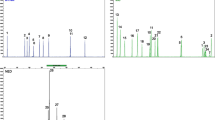Abstract
Here we present a multiplex PCR assay to distinguish three widespread brown frog species, Rana temporaria, R. arvalis and R. amurensis, based on amplified fragment length. The system consists of four primers to the mitochondrial cytochrome c oxidase subunit I gene, with one universal reverse primer and three species-specific forward primers. Therefore, the PCR gives a fragment of a known specific length, which can be identified by electrophoresis in standard agarose gel. The efficiency of the developed assay was confirmed using both pre-identified and unidentified samples.

Similar content being viewed by others
Data Availability
NA.
Code Availability
No custom codes were used.
References
Heatwole H, Wilkinson JW (eds) (2015) Amphibian Biology, volume 11: status of conservation and decline of amphibians: Eastern Hemisphere. Part 4: Southern Europe and Turkey. Pelagic Publishing, Exeter
Kuzmin S (2012) Amphibians of the Former USSR. KMK Scientific Press, Moscow
Kuzmin SL, Dunayev EA, Munkhbayar KH, Munkhbaatar M, Oyuunchimeg J, Terbish KH (2017) The amphibians of Mongolia. KMK Scientific Press, Moscow
Loman J (1978) Macro- and microhabitat distribution in Rana arvalis and R. temporaria (Amphibia, Anura, Ranidae) during summer. J Herpetol 12:29–33. https://doi.org/10.2307/1563499
Stugren B (1966) Geographic variation and distribution of the moor frog, Rana arvalis Nilss. Ann Zool Fenn 3:29–39
Terbish Kh M, Kh, Clark EL, (compilers and editors) et al (2006) Mongolian Red List of reptiles and amphibians. Regional Red List Series, vol 5. Zoological Society of London, London
Funding
The study was supported by the Russian Science Foundation (grant no. 21-74-10107).
Author information
Authors and Affiliations
Contributions
ES conceived and designed the study. OE designed the assay and primers. AS, AL and ES conducted the fieldwork. PC and AL conducted the experiments. PC and ES analyzed the data. PC wrote the initial draft of the manuscript. All authors discussed the results, contributed to the draft, read the final manuscript, and gave approval for publication.
Corresponding author
Ethics declarations
Competing interests
The authors declare no competing interests.
Ethics approval
Ethical approval from Biomedical Ethic Committee of Tyumen State University (record no. 4\15.12.2021).
Consent to participate/consent of publication
NA (no human participants in the study).
Clinical trials registration
NA.
Gels and blots/image manipulation
No manipulations were done.
Additional information
Publisher’s Note
Springer Nature remains neutral with regard to jurisdictional claims in published maps and institutional affiliations.
Electronic supplementary material
Below is the link to the electronic supplementary material.
Rights and permissions
Springer Nature or its licensor (e.g. a society or other partner) holds exclusive rights to this article under a publishing agreement with the author(s) or other rightsholder(s); author self-archiving of the accepted manuscript version of this article is solely governed by the terms of such publishing agreement and applicable law.
About this article
Cite this article
Chernigova, P., Ermakov, O., Lisachev, A. et al. Multiplex PCR assay to distinguish among three widespread brown frog species. Conservation Genet Resour 16, 7–9 (2024). https://doi.org/10.1007/s12686-023-01338-y
Received:
Accepted:
Published:
Issue Date:
DOI: https://doi.org/10.1007/s12686-023-01338-y




